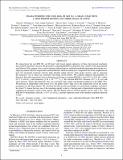CHARACTERIZING THE COOL KOIs. III. KOI 961: A SMALL STAR WITH LARGE PROPER MOTION AND THREE SMALL PLANETS
Author(s)
Muirhead, Philip S.; Johnson, John Asher; Apps, Kevin; Carter, Joshua Adam; Morton, Timothy D.; Fabrycky, Daniel C.; Pineda, John Sebastian; Bottom, Michael; Schlawin, Everett; Hamren, Katherine; Covey, Kevin R.; Crepp, Justin R.; Pepper, Joshua; Hebb, Leslie; Kirby, Evan N.; Howard, Andrew W.; Isaacson, Howard; Marcy, Geoffrey W.; Levitan, David; Diaz-Santos, Tanio; Armus, Lee; Lloyd, James P.; Stassun, Keivan; Rojas-Ayala, Barbara; ... Show more Show less
DownloadMuirhead-2012-CHARACTERIZING THE C.pdf (2.719Mb)
PUBLISHER_POLICY
Publisher Policy
Article is made available in accordance with the publisher's policy and may be subject to US copyright law. Please refer to the publisher's site for terms of use.
Terms of use
Metadata
Show full item recordAbstract
We characterize the star KOI 961, an M dwarf with transit signals indicative of three short-period exoplanets discovered by the Kepler mission. We proceed by comparing KOI 961 to Barnard's Star, a nearby, well-characterized mid-M dwarf. We compare colors, optical and near-infrared spectra, and find remarkable agreement between the two, implying similar effective temperatures and metallicities. Both are metal-poor compared to the Solar neighborhood, have low projected rotational velocity, high absolute radial velocity, large proper motion, and no quiescent Hα emission—all of which are consistent with being old M dwarfs. We combine empirical measurements of Barnard's Star and expectations from evolutionary isochrones to estimate KOI 961's mass (0.13 ± 0.05 M [subscript ☉]), radius (0.17 ± 0.04 R [subscript ☉]), and luminosity (2.40 × 10[superscript –3.0 ± 0.3] L [subscript ☉]). We calculate KOI 961's distance (38.7 ± 6.3 pc) and space motions, which, like Barnard's Star, are consistent with a high scale-height population in the Milky Way. We perform an independent multi-transit fit to the public Kepler light curve and significantly revise the transit parameters for the three planets. We calculate the false-positive probability for each planet candidate, and find a less than 1% chance that any one of the transiting signals is due to a background or hierarchical eclipsing binary, validating the planetary nature of the transits. The best-fitting radii for all three planets are less than 1 R [subscript ⊕], with KOI 961.03 being Mars-sized (R[subscript P] = 0.57 ± 0.18 R [subscript ⊕]), and they represent some of the smallest exoplanets detected to date.
Date issued
2012-02Department
Massachusetts Institute of Technology. Department of PhysicsJournal
The Astrophysical Journal
Publisher
IOP Publishing
Citation
Muirhead, Philip S., John Asher Johnson, Kevin Apps, Joshua A. Carter, Timothy D. Morton, Daniel C. Fabrycky, John Sebastian Pineda, et al. “CHARACTERIZING THE COOL KOIs. III. KOI 961: A SMALL STAR WITH LARGE PROPER MOTION AND THREE SMALL PLANETS.” The Astrophysical Journal 747, no. 2 (February 24, 2012): 144. © 2012 The American Astronomical Society
Version: Final published version
ISSN
0004-637X
1538-4357